
Welcome to newjerseysnakes.com! I am David, a snake enthusiast living in New Jersey, NJ. Many people don't know that New Jersey is in fact full of snakes! You just need to know where to find them - they can often be shy and elusive. Some New Jersey snake species are more common outside of the city limits, in different parts of Hudson County NJ, but many types of snakes are indeed common in the more urban parts of New Jersey. This guide is meant to help educate you about the beautiful snakes of New Jersey, and to help you identify the most common snakes of New Jersey, as well as the venomous snakes of New Jersey that you should learn to recognize and avoid. If you want more detail, click here for my complete list of ALL snake species in New Jersey. Remember the following:
- Most snakes of New Jersey are harmless and don't want to encounter you
- Venomous snakes exist but are uncommon in New Jersey, New Jersey
- Snakes eat rats and mice and are a valuable part of the New Jersey ecosystem
- Never kill a snake - if you leave a snake alone, it will leave you alone.
Common Snake Species in New Jersey
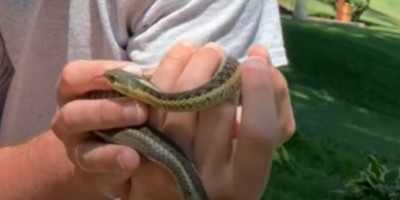 Garter Snake:
New Jersey has a total of twenty-two common types of snakes, one of the most common ones being the garter snake. This species is often found in habitats where there are fields and water nearby.
In color, they vary from olive to brown to even black. But to identify them easier, they have three visible stripes on them. One is on their back and the other two on each side of their body.
The stripes are usually a yellow color but can sometimes be green, brown, or bluish.
Garter Snake:
New Jersey has a total of twenty-two common types of snakes, one of the most common ones being the garter snake. This species is often found in habitats where there are fields and water nearby.
In color, they vary from olive to brown to even black. But to identify them easier, they have three visible stripes on them. One is on their back and the other two on each side of their body.
The stripes are usually a yellow color but can sometimes be green, brown, or bluish.
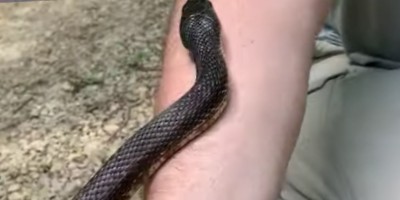 Black Rat Snake:
The black rat snake has a lot of similarities with the black racer, particularly because they are found in common habitats.
They are plain black in color with a white chin and throat along with either a white or pale yellow belly. Compared to the racer, they are slightly bulkier.
Juvenile black rat snakes are commonly mistaken as timber rattlesnakes because they are gray with dark brown or gray blotches on their backs.
The black rat snakes are also known as climbers. They can be found in trees or even rock crevices.
Black Rat Snake:
The black rat snake has a lot of similarities with the black racer, particularly because they are found in common habitats.
They are plain black in color with a white chin and throat along with either a white or pale yellow belly. Compared to the racer, they are slightly bulkier.
Juvenile black rat snakes are commonly mistaken as timber rattlesnakes because they are gray with dark brown or gray blotches on their backs.
The black rat snakes are also known as climbers. They can be found in trees or even rock crevices.
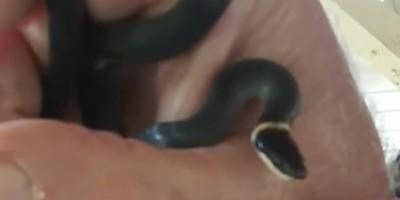 Ring-necked Snake:
This snake reaches up to 30 inches in length as adults and is found all around the state, mostly in woodlands or rocky areas. Usually, they reside under logs and stones.
They have a dark back with a golden neck collar while their belly is commonly a plain yellow color with a few black spots. Their scales are also rather smooth compared to other species.
Their venom is also weak, which makes them harmless to humans, but enough for them to keep their prey subdued.
Ring-necked Snake:
This snake reaches up to 30 inches in length as adults and is found all around the state, mostly in woodlands or rocky areas. Usually, they reside under logs and stones.
They have a dark back with a golden neck collar while their belly is commonly a plain yellow color with a few black spots. Their scales are also rather smooth compared to other species.
Their venom is also weak, which makes them harmless to humans, but enough for them to keep their prey subdued.
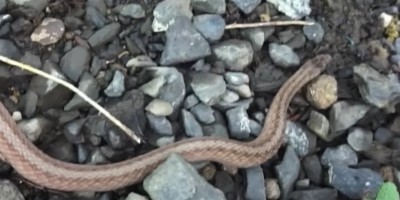 Northern Brown Snake:
The brown snake resides in moist woodlands and lowland habitats, sometimes also in rural and suburban areas.
Similar to the ring-necked snake, they tend to hide under logs, rocks, and other debris found on the ground.
They have a vertical bar a short distance away from their eyes and two rows of dark spots down their back -which are key identifying marks. In color, they range from dark brown to gray with either a yellowish or reddish tone.
Northern Brown Snake:
The brown snake resides in moist woodlands and lowland habitats, sometimes also in rural and suburban areas.
Similar to the ring-necked snake, they tend to hide under logs, rocks, and other debris found on the ground.
They have a vertical bar a short distance away from their eyes and two rows of dark spots down their back -which are key identifying marks. In color, they range from dark brown to gray with either a yellowish or reddish tone.
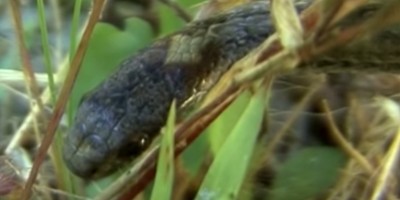 Northern Redbelly:
While the redbelly snake is common in the state, they are rather difficult to find.
In size, they reach only up to 16 inches as adults. Their color is either brown, gray, or black with a red unmarked underside along with three pale spots on their neck in the area just behind the head.
Commonly, they are located in hedgerows, stone walls, fields, and wood lots.
Northern Redbelly:
While the redbelly snake is common in the state, they are rather difficult to find.
In size, they reach only up to 16 inches as adults. Their color is either brown, gray, or black with a red unmarked underside along with three pale spots on their neck in the area just behind the head.
Commonly, they are located in hedgerows, stone walls, fields, and wood lots.
Venomous Snake Species in New Jersey
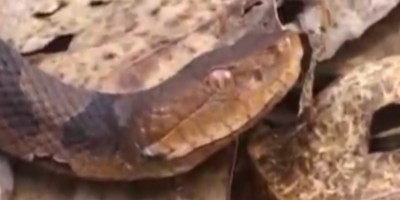 Northern Copperhead:
There are two venomous snakes commonly found in New Jersey. One of those is the northern copperhead reaching up to 53 inches in length.
They are two shades of copper or reddish-brown, wherein the lighter color is for the background while the darker is for their pattern forming an hourglass shape across its body.
No reports have been made of death from the copperhead’s bite. However, since they are venomous, their bites will require immediate medical treatment.
Northern Copperhead:
There are two venomous snakes commonly found in New Jersey. One of those is the northern copperhead reaching up to 53 inches in length.
They are two shades of copper or reddish-brown, wherein the lighter color is for the background while the darker is for their pattern forming an hourglass shape across its body.
No reports have been made of death from the copperhead’s bite. However, since they are venomous, their bites will require immediate medical treatment.
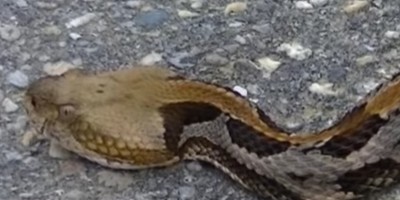 Timber Rattlesnake:
Another venomous species located in New Jersey is the timber rattlesnake -which is also known to be a state endangered species.
Their colors range from yellow to brown with either black or dark brown jagged V-shaped bands and blotches that go towards the head. They are sometimes black as well, which makes the pattern unclear.
Their heads are unmarked and the last few inches of their tails, as adults, are a solid black or dark brown color.
Despite the dangers of their bite, they have not been reported to have killed humans from this. Regardless, their bites may need to get treated immediately.
br>
Timber Rattlesnake:
Another venomous species located in New Jersey is the timber rattlesnake -which is also known to be a state endangered species.
Their colors range from yellow to brown with either black or dark brown jagged V-shaped bands and blotches that go towards the head. They are sometimes black as well, which makes the pattern unclear.
Their heads are unmarked and the last few inches of their tails, as adults, are a solid black or dark brown color.
Despite the dangers of their bite, they have not been reported to have killed humans from this. Regardless, their bites may need to get treated immediately.
br>If you're unsure, you can email me a photo of the snake at info@newjerseysnakes.com and I will email you back with the snake's species. If you found a snake skin, read my Found a Skin? page, and you can email me a photo of the skin, and I'll identify the snake for you. If you need professional New Jersey snake removal help, click my Get Help page, or see the below website sponsor I found, who provides that service.
Remember, the term is not poisonous snakes of New Jersey, it's venomous snakes of New Jersey. Poison is generally something you eat, and venom is injected into you. That said, dangerous snakes are very rare in New Jersey. The few venomous snakes of Hudson County are rarely seen. But they are commonly misidentified, so learn about all the snake species of New Jersey in order to correctly identify them. These snakes are usually also found in the surrounding towns of Jersey City, Paterson, Elizabeth, Edison, Woodbridge, Lakewood, Toms River, Hamilton, Trenton, Clifton, Camden, Brick, Cherry Hill, Passaic, Middletown, Union City, Old Bridge, Gloucester Township, East Orange, Bayonne, Franklin Township, North Bergen, Vineland, Union, Piscataway, New Brunswick, Jackson, Wayne, Irvington, Parsippany, Howell, Perth Amboy, Hoboken, Plainfield, West New York, Washington Township, East Brunswick, Bloomfield, West Orange, Evesham Township, Bridgewater, South Brunswick, Egg Harbor Township, Manchester, Hackensack, Sayreville, Mount Laurel, Berkeley Township, North Brunswick, Kearny, Linden, Marlboro, Teaneck, Atlantic City, Winslow Township, Monroe Township, Manalapan, Hillsborough, Montclair, Galloway Township, Freehold Township, Belleville, Pennsauken,K Ewing, Fort Lee, Lawrence, Fair Lawn, Willingboro, Long Branch, Deptford, Garfield, Westfield, City of Orange, Livingston, Voorhees, Princeton, Millville, Nutley, Mount Olive, Neptune, Pemberton Township, Lacey Township, Rahway, Ocean Township, East Windsor, West Windsor, Englewood, Bergenfield, Bernards Township, Stafford Township, Hamilton Township, Paramus, Wall Township, Mahwah, West Milford, Randolph, Bridgeton, Ridgewood, and the surrounding areas.
Read our article about:
Understanding The Corn Snake: Appearance, Biology, Life Cycle, Habitat, Diet, Behavior
newjerseysnakes.com domain and hosting costs made possible by the generous support of this sponsor:
